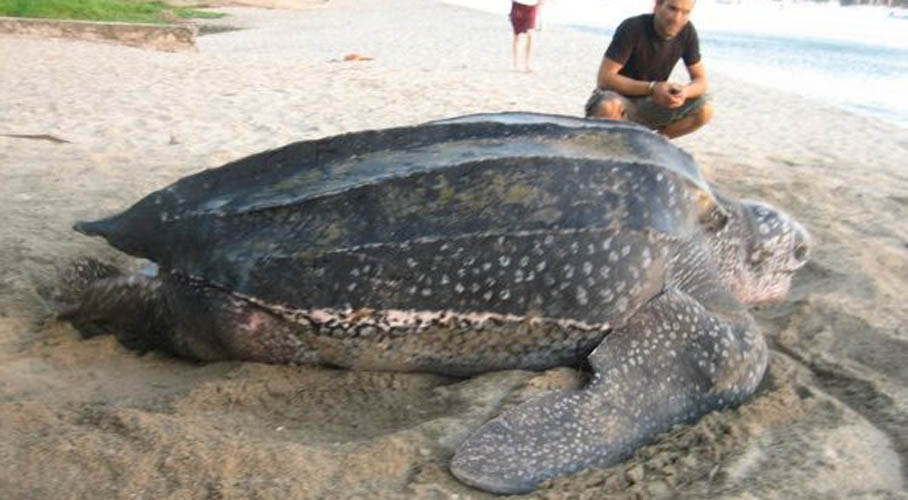With great emotion, the marine turtle biologist, Graciela Tiburcio Pintos, recounted how at dawn on Tuesday, December 29, a leatherback turtle, a specimen in critical danger of extinction, came out to spawn at one of the beaches of Los Cabos.
Turtles will hatch in 60 days; protect the site to prevent damage to the eggs
Los Cabos, Baja California Sur.– The Network for the Protection of the Sea Turtle of the municipality of Los Cabos maintains two protected leatherback nests and three with the eggs in incubators, with only five spawnings of this species in the last 10 years; the most recent, in front of a beach of a hotel in the San José del Cabo-Cabo San Lucas tourist corridor, with a specimen weighing approximately 600 kilos.

The report of the presence of the huge sea turtle was made by security personnel of the Hotel Ventanas (Member of the Network for the Protection of the Sea Turtle), who indicated that the gigantic leatherback turtle left to spawn. The specimen weighing more than half a ton and about 2.5 meters long, spawned 110 eggs.
“Upon arrival, I was pleasantly surprised as security elements were guarding the area to prevent the turtle from being disturbed and ready to protect the nest as soon as spawning began. Fernando Duarte, Fernando H. Luz, Giovani Pérez, Efraín Aparicio, Daniel Osorio and a servant we were pending and protected the brood, ”said biologist Tiburcio Pintos.
“The turtle was a specimen of more than half a ton and around 2.5 m long. A majestic animal and everyone is lucky to see it, as this species is ‘Critically Endangered’. Experts consider that if the problems that are decreasing their populations are not stopped, the leatherback turtles are likely to become extinct in the coming decades, “she said.
A total of 110 eggs were protected, which were transferred to the incubation chamber of the Hotel Hacienda.
Biologist Graciela Tiburcio, technical manager of this organization, reported that it is a species in critical danger of extinction, a phenomenon attributable to incidental fishing in the open sea with gillnets and longlines, to which is added the pressure on the coastline with the egg theft and loss of beaches due to tourist developments.
She explained that 2020 was an exceptional year throughout the Mexican Pacific, with a good number of nesting reports, but emphasized that this indicates that the species is recovering, and continues in the same status, even with some specialists who point out that the lute could be extinguished in two decades if the same problem continues.
It is not known with certainty which are the laud routes, although some satellite monitoring indicates that they travel from north to south and vice versa through the Mexican Pacific; What is known is that they live in the open sea and only come close to the coasts during the nesting period that begins in November and ends in February.
Graciela Tiburcio reported that in Los Cabos the Turtle Protection Network was between 10 and 12 years old and did not register the presence of a specimen of this species and recalled that when this program began they had up to 100 protected nests; In recent years there have been only three, and in 2020 there were five, some between Buenavista and Los Barriles.
She explained that the eggs that are taken to the incubator take between 60 and 70 days to hatch, time in which they are kept at a controlled temperature and protected and once the turtles are born they are preferably released on the same beach where they were deposited.
It is estimated that for every 10,000 leatherback turtles that are born, only one survives and its life horizon is up to 150 years; A turtle can lay between 80 and 100 eggs but only 60 percent are fertile, and in the case of the turtle that nested a few days ago in Los Cabos, it was protected thanks to the timely intervention of the hotel staff that is located in front of the nesting site that is also part of LaRed for the Protection of the Sea Turtle.
On the other hand, the person in charge of the technical area of the Network for the Protection of the Sea Turtle, recalled that 20 years of workshops and with more than 3,000 people trained, today, Los Cabos has a Network with high national and international standards in the conservation of sea turtles, which is demonstrated with excellent results during each nesting season.
Finally, he thanked all the members of the Network, but today especially the Hotel Ventanas and all the staff who made possible the protection of the female and her nest.
Source: elsudcaliforniano.com.mx





